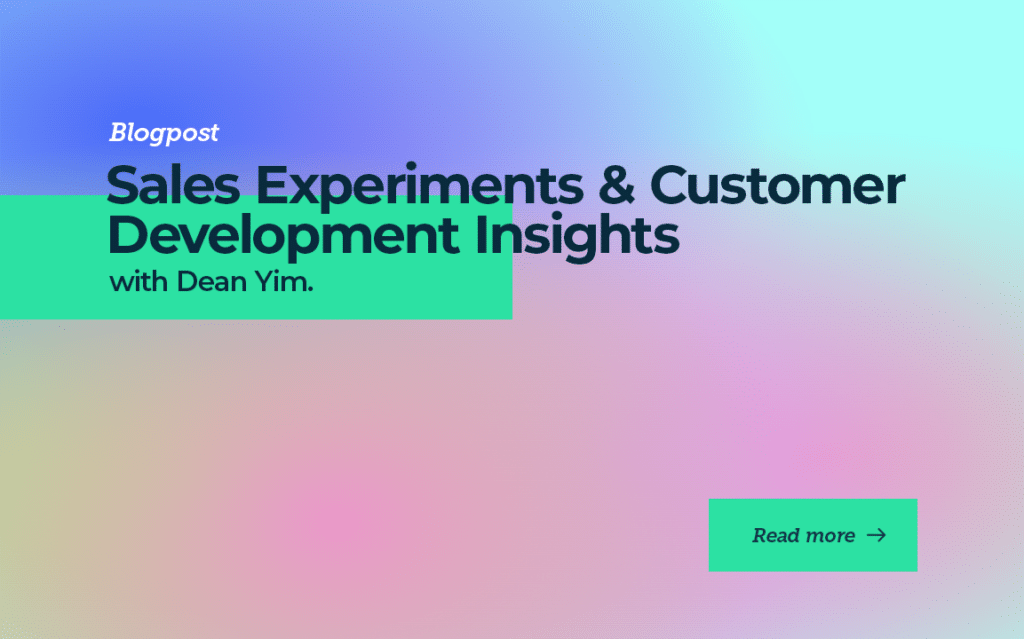Sales Experiments & Customer Development Insights with Dean Yim

A quick step-back
Initially, Dean and his co-founder had an idea for their company, which focused on running an outsourcing company. They stood out by offering a unique job simulator assessment for outsourcing customer support instead of traditional multiple-choice tests. This innovative approach resonated with potential customers, leading them to shift their focus to this aspect of the business.
While dedicated to this new approach, they realized the customer support sector had limited demand for large numbers of personnel. They decided to apply the job simulator concept to the sales field, conducting a three-month trial period. Leveraging their sales experience and product compatibility, they agreed to try it.
The 3-month Sales Experiment
Believing sales to be a suitable use case, especially with their connections in the B2B SaaS industry, Dean and his co-founder targeted mid-sized B2B SaaS companies. They set a timeline from January 20th to April 25th to build a demo product to secure at least one annual contract. Once achieved, their next milestone was to aim for $100,000 in revenue within three months. They joined an accelerator program to stay on track, with self-imposed requirements and deadlines to maintain focus and test their ability to sell successfully within a specific timeframe.
This accelerator experience differed from their previous participation in Y Combinator (YC) in 2016, as it lacked the constant presence of YC partners. Without that support, Dean’s co-founder proposed a three-month plan to establish clear goals and develop good habits independently.
Adding constraints can be beneficial when launching sales or product initiatives. Striving for perfection over an extended 18-month timeline can hinder progress, as it delays obtaining crucial feedback through customer development calls. Staggered feedback from different sources simultaneously makes it challenging to incorporate and synthesize the feedback effectively.
By condensing the feedback into a shorter period, processing and making sense of the advice received becomes easier. A shorter timeframe allows for regular recaps and learnings at the end of each cycle, enabling adjustments based on what worked well and what didn’t. This approach helps avoid the influence of recency bias and facilitates the iterative improvement of the project.

What were the goals of this experiment?
Dean and his team adopted a specific approach, focusing on one primary goal and a more ambitious second goal. The intention was not to pursue both goals simultaneously but to establish a smaller initial goal as a foundation for the second one.
This approach allowed them to reassess their progress if they failed to achieve the first goal, potentially requiring them to start afresh. On the other hand, reaching the second goal would indicate they were on the right track and could proceed without significant changes.
As anticipated, they achieved the first goal but fell short of the second one. This outcome was expected, as they projected a likelihood of both goals being missed or achieved around half or even a quarter of the time. Overall, this process gave them valuable insights they wouldn’t have gained had they continued without these clear milestones for 13 weeks.
What happened during the experiment?
Dean and his team initially planned to build a sales simulation for B2B SaaS companies with SDR teams. The market downturn led to cost-cutting measures and reduced investment in hiring tools.
During customer development interviews, Dean realized that many calls were mere favors to investor friends rather than genuine interest in their product. He found it demoralizing, but there’s significance to these calls: “These are the most productive calls you could have because the alternative is, you spend 18 months building a tool nobody wants to buy.” – Collin.
Despite initial ease in learning from the first few calls, repeated encounters with disinterest from different B2B SaaS companies made the process challenging. They noted the importance of being involved in sales rather than solely relying on outsourcing firms.
Note: Many founders take a similar path, exploring sales by hiring SDRs or outsourcing firms. While it may seem tempting to hand over the sales problem completely, Dean's experience emphasizes the value of engaging in these calls. They may initially be challenging and unpleasant but eventually become the most productive calls.Before the experiment began, they made educated guesses about their initial customer base, leaving no option other than making these calls. Unfortunately, the process proved ineffective by the end of the fifth or sixth week.
Dean also mentioned the drawbacks of initially not using AI note-taking software, opting to transcribe notes by hand. However, halfway through the experiment, they started using such software, which made the process easier and more efficient.
Into the 2nd month of the experiment
During the second month, Dean and his team realized the ineffectiveness of their initial approach. Dean turned to LinkedIn in search of alternatives, spending about two and a half hours browsing through potential companies that could benefit from their product. This led him to discover a specific type of company called a “sales development outsource” or “lead generation company.”
Dean researched these companies further on platforms like G2 or Clutch.co, identifying around 50 potential outsourcing companies to target. Initiating a cold outreach campaign to them, he received positive responses, finding better fit and more accessible connections than his previous outreach efforts.
Dean learned the nuances of selling software compared to tangible products through customer development calls. There was no established playbook for pitching or receiving software pitches, creating uncertainty for both parties. Thus, the team focused on understanding the needs and preferences of the outsourcing companies they targeted, refining their demo and communication about the product.
The hands-on approach required in this process, highlights how founders possess deep knowledge of the customer and product capabilities. Sales conversations centered around understanding the customer’s problem and evaluating the solution’s alignment with their needs are crucial in finding product-market fit.
In the early stages, identifying the customer’s problem and assessing the solution’s fit is paramount in achieving success.

What was the outcome of the experiment?
While the second goal wasn’t complete, the experiment yielded promising progress in its later stages. Startups, particularly those in series B, expressed interest in hiring sales, prompting them to customize the sales simulation to match their product. This new direction proved fruitful, highlighting the need for a tailored sales simulator instead of a generic one-size-fits-all solution.
The experiment brought forth valuable insights, revealing that targeting mid-sized B2B SaaS companies was not optimal. Customer interviews emphasized the importance of customization, with a greater interest shown when the tool was tailored to their own company. As a result, the focus shifted towards developing software that could quickly adapt the assessment for each outsourced company, delivering specialized tests to showcase the value of the service.
The Last Mile: Fine-Tuning for Success
With their product nearing 85% completion, Dean and his team focused on the crucial last mile. This involved gathering customer feedback, understanding market needs, and making necessary adjustments for success.
While the remaining 15% required adaptation, the development time for these changes was surprisingly minimal. They primarily involved creating assessment types specific to sales, such as cold emails and calls, and replacing the fictitious company in the job simulator with actual customers. However, the main focus was understanding the origin of the last 15% and its significance.
Rather than guessing in the dark, Dean emphasized the importance of intensive customer development calls to find a customer segment that genuinely needed their product. These calls provided invaluable insights and guided them through the growing pains of product refinement.
Gathering information from multiple sources and identifying commonalities among feedback is essential. While not every call may provide perfect accuracy, the key is to extract directionally accurate insights and specific details unique to each company. This process allowed them to determine if there were sufficient commonalities to build a successful business around their product.
Conclusion
Customer development is crucial for founders to succeed in sales. Outsourcing this aspect may overlook its significance.
As Dean stated, “Identifying the moments when the person you’re talking to gets excited” is vital. Engaging in customer development calls uncovers genuine interest. Hiring AEs creates separation from the customer and an extra layer of separation between you and the customer with the problem.
PS. The spark in someone's eyes when they realize your product's possibilities represents the magical moment founders chase. It signifies the discovery of unmet needs. That spark in their eyes means discovering them. It's the moment when they say, 'Oh, wow! You can do this?'" Prioritize customer development, embrace these moments, and adapt your approach as a founder.
NO TIME TO READ?
Listen On:



